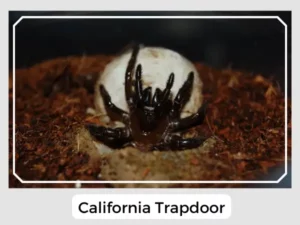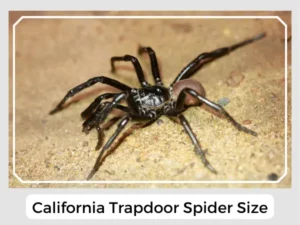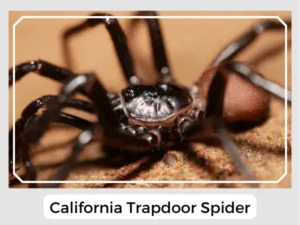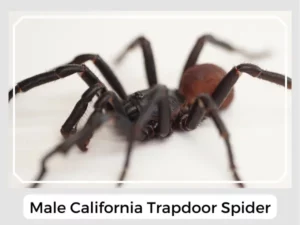Get ready to learn about the spiders from the Ctenizidae family! Often called California trapdoor spiders, they live not just in California but all across the United States. These spiders have some pretty neat tricks up their sleeves.

Photo Credit: Kevin Lentz

Photo Credit: Tobi Hays
After copulation, females lay eggs in the burrows, 7-8 inches deep. The mother takes the utmost care of her eggs, hanging them up on a silk cradle wall.
After hatching, the spiderlings remain dependent on their mother for a few days, especially during the first winter. Throughout this phase, the mother feeds them. Then they leave their burrows and start building their web.
Californian trapdoor spiders do not build full-fledged webs; instead, they dig up burrows and make trap gates with their silk.
Yes, California Trapdoor spiders do have venom. They use it mainly to paralyze their prey. Their venom isn’t dangerous to humans.
Indeed, they can! They might bite if they feel trapped or scared. It’s a good idea to observe them without touching them.

Photo Credit: Tobi Hays
California trapdoor spiders are critical ecological agents, maintaining the insect population and enriching soil quality through their burrowing activities.
Natural Predators: These spiders face predation from various animals, which plays a role in the control of their populations and the broader ecological balance.
Prey-Predator Dynamics: By hunting a variety of invertebrates, they help to regulate these populations, contributing to the ecological health of their habitats.
Relationship with Humans: Despite their venom and capacity to bite, California trapdoor spiders have a relatively peaceful coexistence with humans and can even be part of the pet trade due to their unique characteristics.
| Distribution | California |
| Habitat | Damp and moist soil |
| Lifespan | 5-20 years |
| Predators | Scorpions, flies, birds, and centipedes |
| Web-type | Trap door |
| Diet | Millipedes, insects and arthropods |

Photo Credit: Tobi Hays
In summary, the California trapdoor spider is a species that showcases the marvels of nature’s engineering and the complex interplay between different organisms within an ecosystem.
Get ready to learn about the spiders from the Ctenizidae family! Often called California trapdoor spiders, they live not just in California but all across the United States. These spiders have some pretty neat tricks up their sleeves.

Photo Credit: Kevin Lentz

Photo Credit: Tobi Hays
After copulation, females lay eggs in the burrows, 7-8 inches deep. The mother takes the utmost care of her eggs, hanging them up on a silk cradle wall.
After hatching, the spiderlings remain dependent on their mother for a few days, especially during the first winter. Throughout this phase, the mother feeds them. Then they leave their burrows and start building their web.
Californian trapdoor spiders do not build full-fledged webs; instead, they dig up burrows and make trap gates with their silk.
Yes, California Trapdoor spiders do have venom. They use it mainly to paralyze their prey. Their venom isn’t dangerous to humans.
Indeed, they can! They might bite if they feel trapped or scared. It’s a good idea to observe them without touching them.

Photo Credit: Tobi Hays
California trapdoor spiders are critical ecological agents, maintaining the insect population and enriching soil quality through their burrowing activities.
Natural Predators: These spiders face predation from various animals, which plays a role in the control of their populations and the broader ecological balance.
Prey-Predator Dynamics: By hunting a variety of invertebrates, they help to regulate these populations, contributing to the ecological health of their habitats.
Relationship with Humans: Despite their venom and capacity to bite, California trapdoor spiders have a relatively peaceful coexistence with humans and can even be part of the pet trade due to their unique characteristics.
| Distribution | California |
| Habitat | Damp and moist soil |
| Lifespan | 5-20 years |
| Predators | Scorpions, flies, birds, and centipedes |
| Web-type | Trap door |
| Diet | Millipedes, insects and arthropods |

Photo Credit: Tobi Hays
In summary, the California trapdoor spider is a species that showcases the marvels of nature’s engineering and the complex interplay between different organisms within an ecosystem.